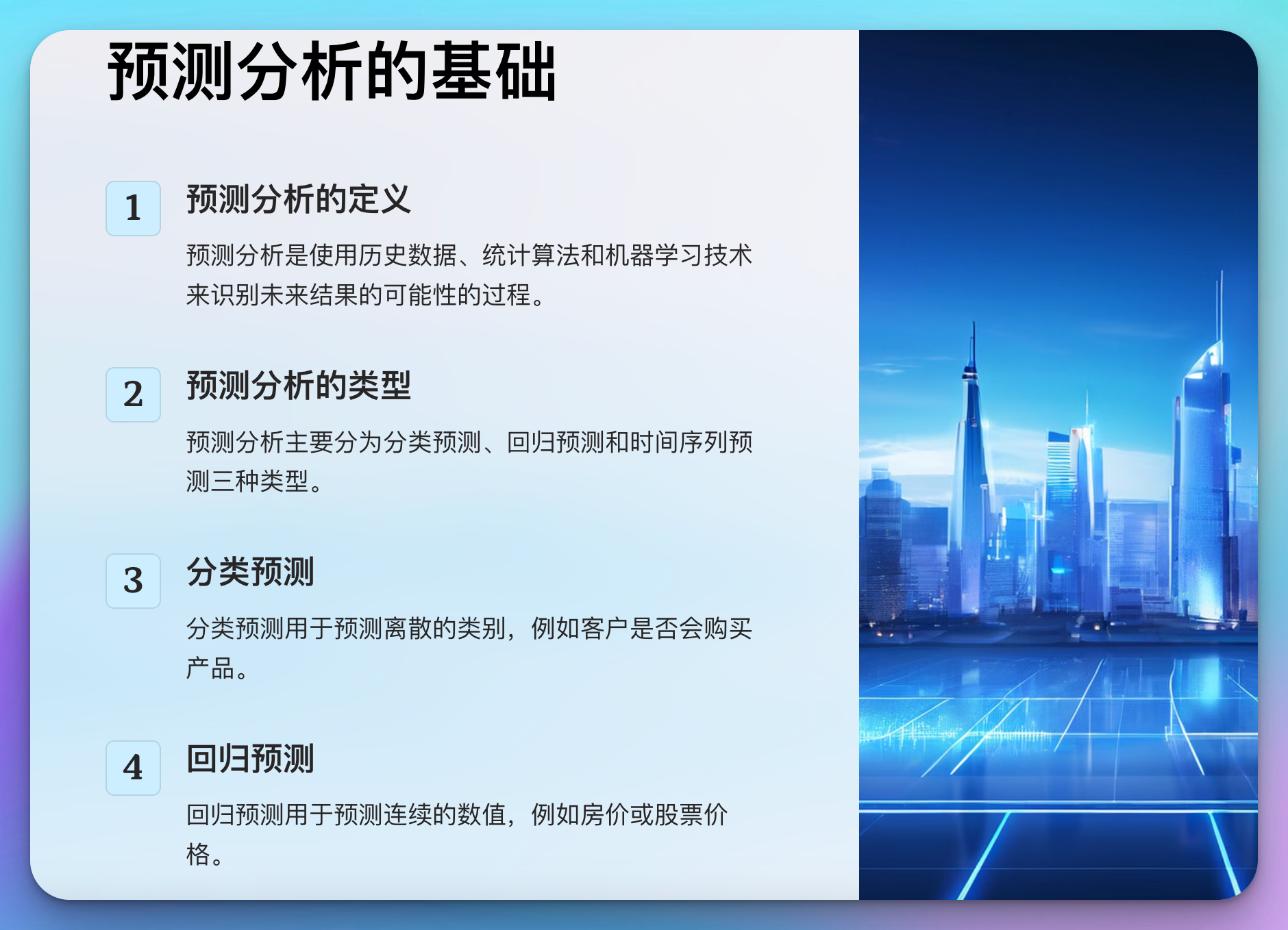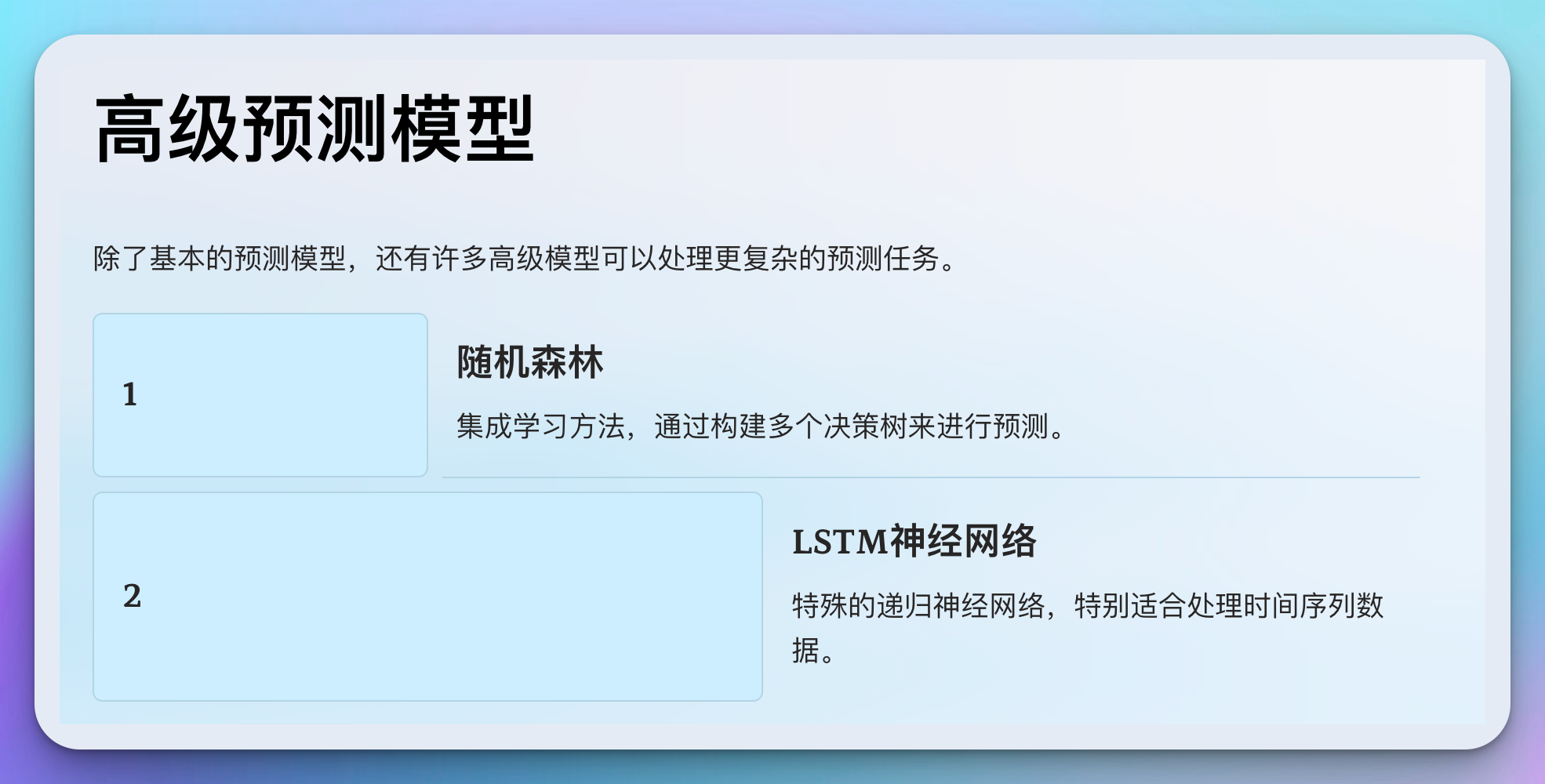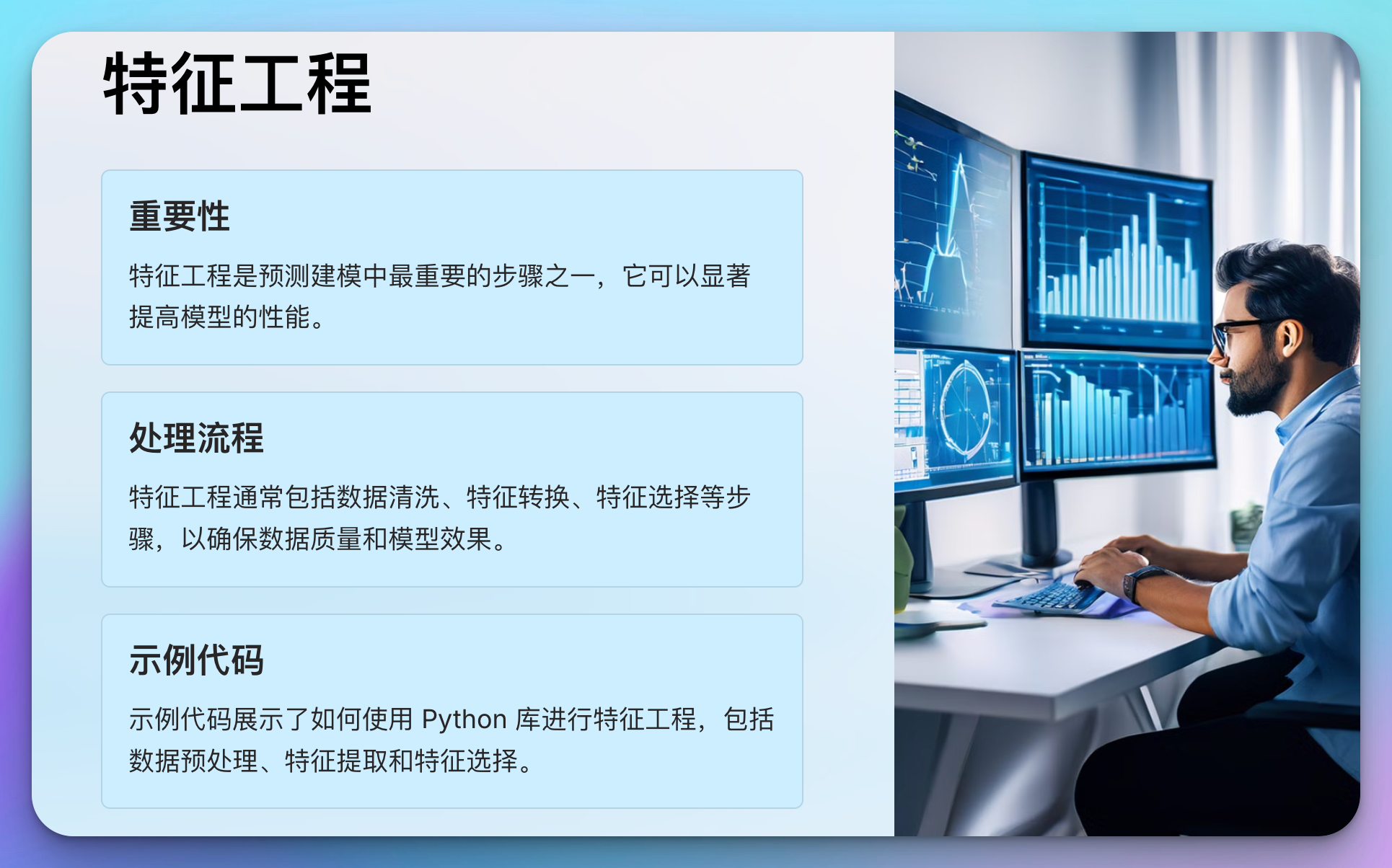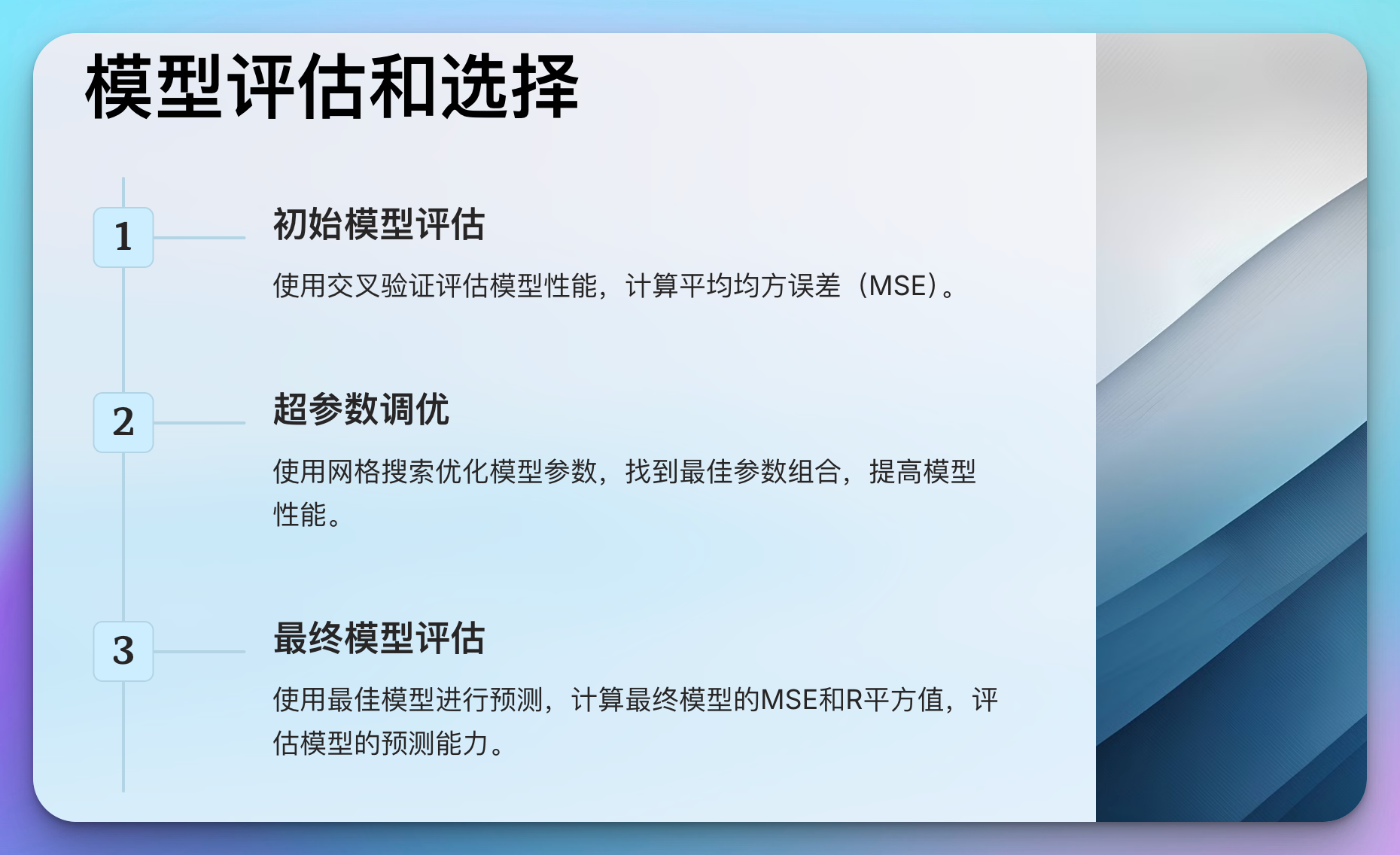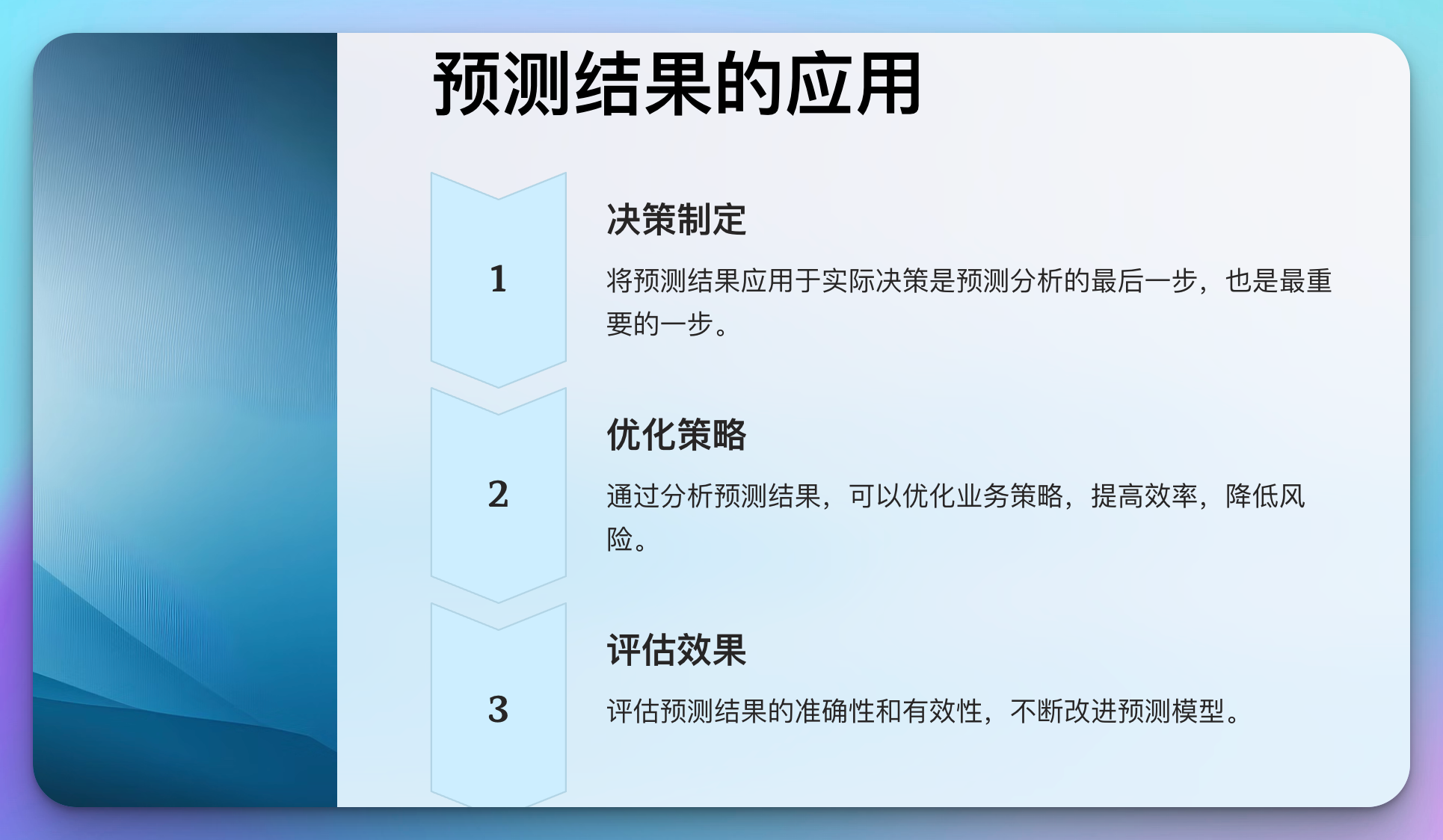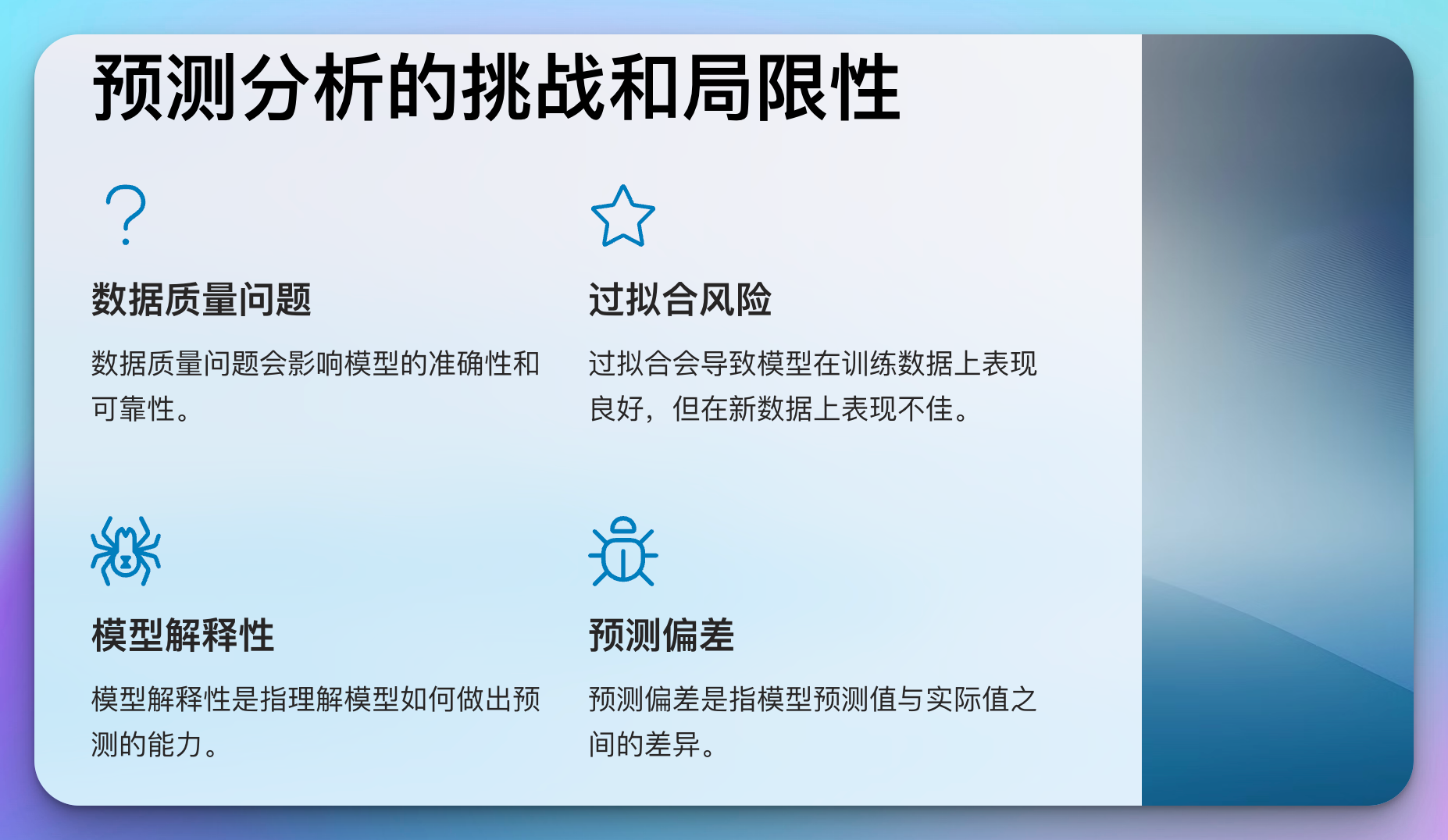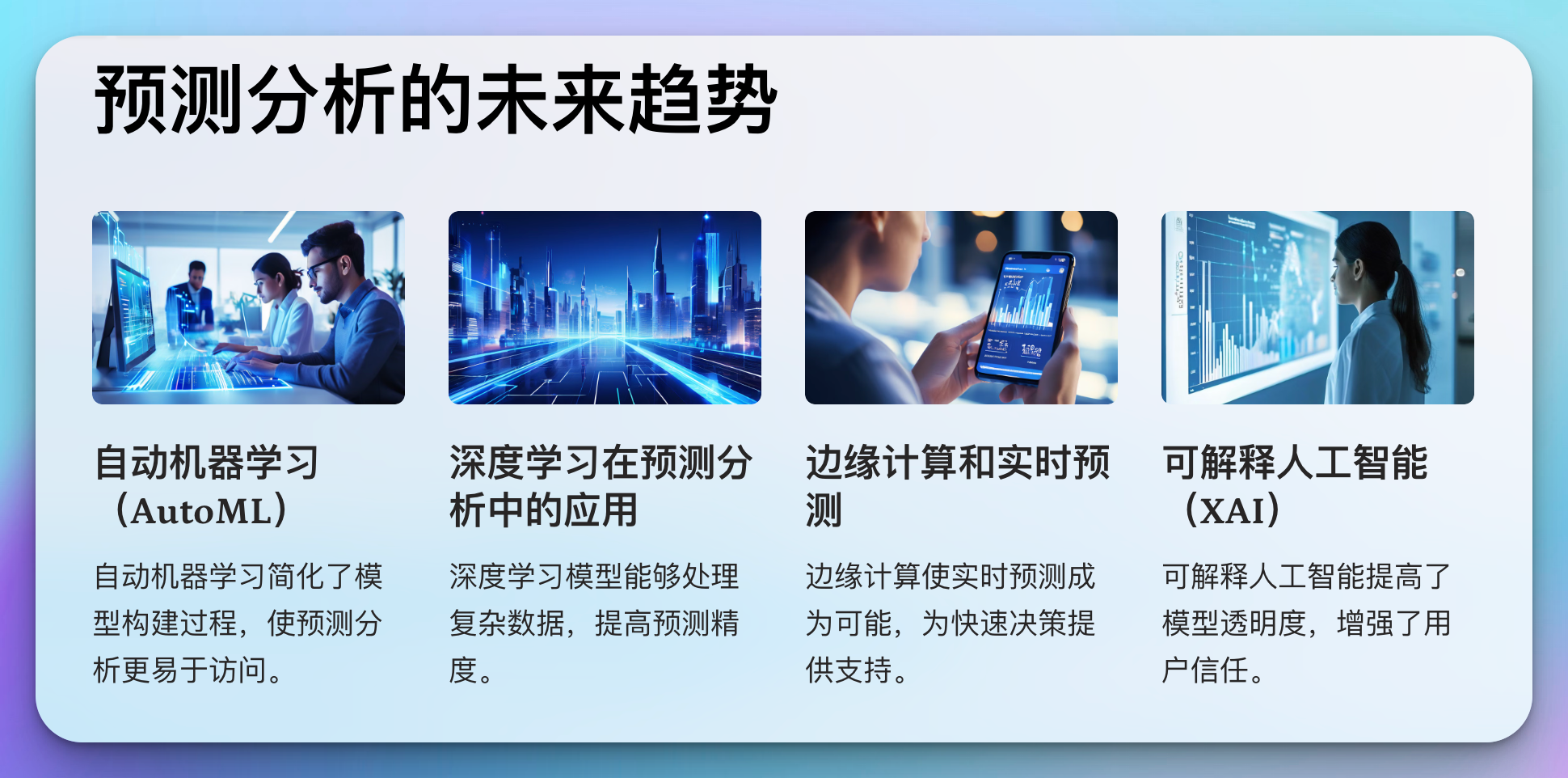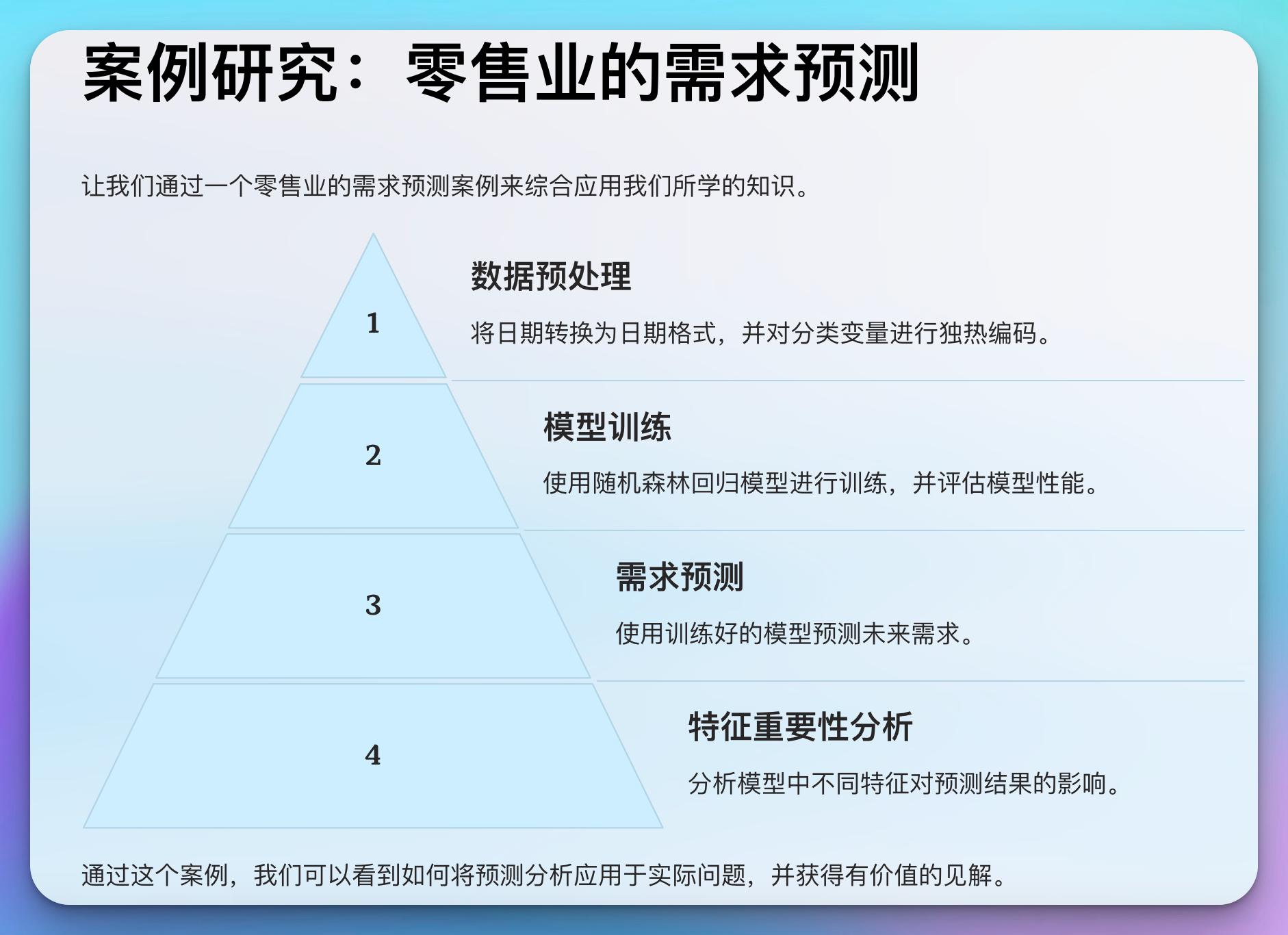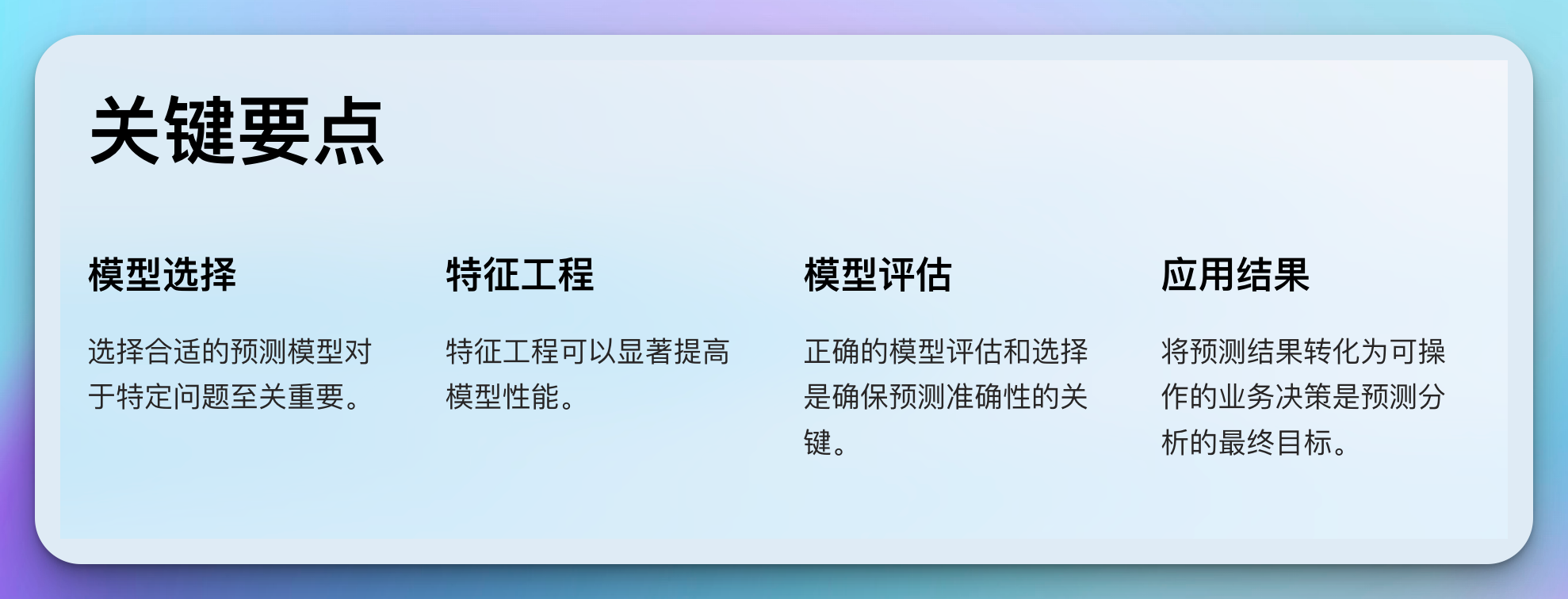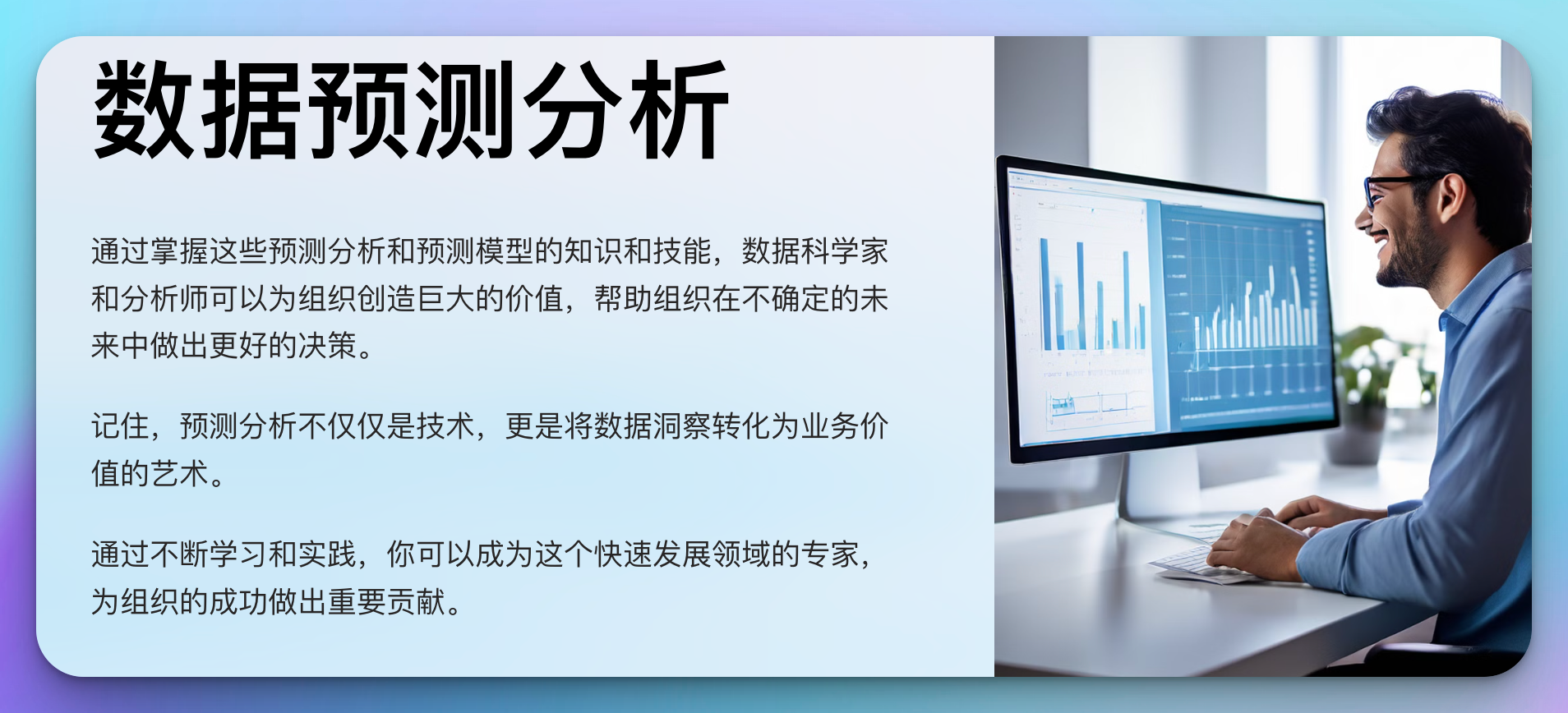在数据驱动的决策时代,预测分析和预测模型已成为组织的重要战略工具。通过分析历史数据,我们可以预测未来趋势,做出更明智的决策。本文将深入探讨预测分析的核心概念、常用技术和实际应用。
目录
1. 预测分析的基础
预测分析是使用历史数据、统计算法和机器学习技术来识别未来结果的可能性的过程。
1.1 预测分析的类型
- 分类预测:预测离散的类别
- 回归预测:预测连续的数值
- 时间序列预测:基于时间序列数据进行预测
import pandas as pd
import numpy as np
from sklearn.model_selection import train_test_split
from sklearn.metrics import classification_report, mean_squared_error
from sklearn.linear_model import LogisticRegression, LinearRegression
from statsmodels.tsa.arima.model import ARIMA
class PredictiveAnalytics:
def __init__(self):
pass
def classification_prediction(self, X, y):
X_train, X_test, y_train, y_test = train_test_split(X, y, test_size=0.2, random_state=42)
model = LogisticRegression()
model.fit(X_train, y_train)
y_pred = model.predict(X_test)
print(classification_report(y_test, y_pred))
def regression_prediction(self, X, y):
X_train, X_test, y_train, y_test = train_test_split(X, y, test_size=0.2, random_state=42)
model = LinearRegression()
model.fit(X_train, y_train)
y_pred = model.predict(X_test)
mse = mean_squared_error(y_test, y_pred)
print(f"Mean Squared Error: {mse}")
def time_series_prediction(self, data, order=(1,1,1)):
model = ARIMA(data, order=order)
results = model.fit()
forecast = results.forecast(steps=5)
print("Forecasted values:")
print(forecast)
# 使用示例
analytics = PredictiveAnalytics()
# 分类预测
X_class = np.random.rand(100, 2)
y_class = np.random.choice([0, 1], 100)
analytics.classification_prediction(X_class, y_class)
# 回归预测
X_reg = np.random.rand(100, 1)
y_reg = 2 * X_reg + 1 + np.random.randn(100, 1) * 0.1
analytics.regression_prediction(X_reg, y_reg)
# 时间序列预测
time_series_data = pd.Series(np.random.randn(100))
analytics.time_series_prediction(time_series_data)
2. 高级预测模型
除了基本的预测模型,还有许多高级模型可以处理更复杂的预测任务。
2.1 随机森林
随机森林是一种集成学习方法,通过构建多个决策树来进行预测。
from sklearn.ensemble import RandomForestRegressor
from sklearn.datasets import make_regression
def random_forest_prediction():
X, y = make_regression(n_samples=100, n_features=4, noise=0.1)
X_train, X_test, y_train, y_test = train_test_split(X, y, test_size=0.2, random_state=42)
model = RandomForestRegressor(n_estimators=100, random_state=42)
model.fit(X_train, y_train)
y_pred = model.predict(X_test)
mse = mean_squared_error(y_test, y_pred)
print(f"Random Forest Mean Squared Error: {mse}")
feature_importance = model.feature_importances_
for i, importance in enumerate(feature_importance):
print(f"Feature {i+1} importance: {importance}")
random_forest_prediction()
2.2 LSTM神经网络
长短期记忆(LSTM)网络是一种特殊的递归神经网络,特别适合处理时间序列数据。
from tensorflow.keras.models import Sequential
from tensorflow.keras.layers import LSTM, Dense
from sklearn.preprocessing import MinMaxScaler
def lstm_prediction():
# 生成示例时间序列数据
time_steps = np.linspace(0, 100, 1000)
data = np.sin(time_steps) + np.random.normal(0, 0.1, 1000)
# 数据预处理
scaler = MinMaxScaler()
data_scaled = scaler.fit_transform(data.reshape(-1, 1))
# 准备训练数据
def create_sequences(data, seq_length):
sequences = []
targets = []
for i in range(len(data) - seq_length):
seq = data[i:i+seq_length]
target = data[i+seq_length]
sequences.append(seq)
targets.append(target)
return np.array(sequences), np.array(targets)
seq_length = 50
X, y = create_sequences(data_scaled, seq_length)
X = X.reshape((X.shape[0], X.shape[1], 1))
# 构建LSTM模型
model = Sequential([
LSTM(50, activation='relu', input_shape=(seq_length, 1)),
Dense(1)
])
model.compile(optimizer='adam', loss='mse')
# 训练模型
model.fit(X, y, epochs=50, batch_size=32, verbose=0)
# 预测
last_sequence = data_scaled[-seq_length:]
next_prediction = model.predict(last_sequence.reshape(1, seq_length, 1))
next_prediction = scaler.inverse_transform(next_prediction)
print(f"Next predicted value: {next_prediction[0][0]}")
lstm_prediction()
3. 特征工程
特征工程是预测建模中最重要的步骤之一,它可以显著提高模型的性能。
import pandas as pd
import numpy as np
from sklearn.preprocessing import StandardScaler, OneHotEncoder
from sklearn.impute import SimpleImputer
from sklearn.compose import ColumnTransformer
from sklearn.pipeline import Pipeline
def feature_engineering(data):
# 假设我们有一个包含数值和分类特征的数据集
numeric_features = ['age', 'income']
categorical_features = ['gender', 'occupation']
# 创建预处理管道
numeric_transformer = Pipeline(steps=[
('imputer', SimpleImputer(strategy='median')),
('scaler', StandardScaler())
])
categorical_transformer = Pipeline(steps=[
('imputer', SimpleImputer(strategy='constant', fill_value='missing')),
('onehot', OneHotEncoder(handle_unknown='ignore'))
])
preprocessor = ColumnTransformer(
transformers=[
('num', numeric_transformer, numeric_features),
('cat', categorical_transformer, categorical_features)
])
# 拟合和转换数据
X_processed = preprocessor.fit_transform(data)
# 获取特征名称
feature_names = (numeric_features +
preprocessor.named_transformers_['cat']
.named_steps['onehot']
.get_feature_names(categorical_features).tolist())
return pd.DataFrame(X_processed, columns=feature_names)
# 使用示例
data = pd.DataFrame({
'age': [25, 30, np.nan, 40],
'income': [50000, 60000, 75000, np.nan],
'gender': ['M', 'F', 'M', 'F'],
'occupation': ['engineer', 'teacher', np.nan, 'doctor']
})
processed_data = feature_engineering(data)
print(processed_data)
4. 模型评估和选择
选择合适的模型并正确评估其性能是预测分析中的关键步骤。
from sklearn.model_selection import cross_val_score, GridSearchCV
from sklearn.ensemble import RandomForestRegressor
from sklearn.metrics import mean_squared_error, r2_score
def model_evaluation_and_selection(X, y):
# 初始模型评估
model = RandomForestRegressor(random_state=42)
scores = cross_val_score(model, X, y, cv=5, scoring='neg_mean_squared_error')
mse_scores = -scores
print(f"Cross-validation MSE scores: {mse_scores}")
print(f"Average MSE: {np.mean(mse_scores)}")
# 超参数调优
param_grid = {
'n_estimators': [100, 200, 300],
'max_depth': [None, 10, 20, 30],
'min_samples_split': [2, 5, 10]
}
grid_search = GridSearchCV(model, param_grid, cv=5, scoring='neg_mean_squared_error')
grid_search.fit(X, y)
print(f"Best parameters: {grid_search.best_params_}")
print(f"Best cross-validation score: {-grid_search.best_score_}")
# 最终模型评估
best_model = grid_search.best_estimator_
y_pred = best_model.predict(X)
mse = mean_squared_error(y, y_pred)
r2 = r2_score(y, y_pred)
print(f"Final model MSE: {mse}")
print(f"Final model R-squared: {r2}")
# 使用示例
X, y = make_regression(n_samples=100, n_features=4, noise=0.1)
model_evaluation_and_selection(X, y)
5. 预测结果的应用
将预测结果应用于实际决策是预测分析的最后一步,也是最重要的一步。
import numpy as np
import matplotlib.pyplot as plt
class BusinessDecisionMaker:
def __init__(self, predictions, actual_values, costs, revenues):
self.predictions = predictions
self.actual_values = actual_values
self.costs = costs
self.revenues = revenues
def calculate_profit(self, threshold):
decisions = (self.predictions >= threshold).astype(int)
true_positives = np.sum((decisions == 1) & (self.actual_values == 1))
false_positives = np.sum((decisions == 1) & (self.actual_values == 0))
profit = true_positives * self.revenues - false_positives * self.costs
return profit
def find_optimal_threshold(self):
thresholds = np.linspace(0, 1, 100)
profits = [self.calculate_profit(t) for t in thresholds]
optimal_threshold = thresholds[np.argmax(profits)]
max_profit = np.max(profits)
return optimal_threshold, max_profit
def plot_profit_curve(self):
thresholds = np.linspace(0, 1, 100)
profits = [self.calculate_profit(t) for t in thresholds]
plt.figure(figsize=(10, 6))
plt.plot(thresholds, profits)
plt.title('Profit vs Decision Threshold')
plt.xlabel('Threshold')
plt.ylabel('Profit')
plt.grid(True)
plt.show()
# 使用示例
predictions = np.random.rand(1000)
actual_values = np.random.randint(0, 2, 1000)
costs = 100
revenues = 500
decision_maker = BusinessDecisionMaker(predictions, actual_values, costs, revenues)
optimal_threshold, max_profit = decision_maker.find_optimal_threshold()
print(f"Optimal decision threshold: {optimal_threshold:.2f}")
print(f"Maximum profit: ${max_profit:.2f}")
decision_maker.plot_profit_curve()
6. 预测分析的挑战和局限性
尽管预测分析强大,但我们也需要认识到它的一些挑战和局限性:
- 数据质量问题
- 过拟合风险
- 模型解释性
- 预测偏差
- 处理不确定性
class PredictiveAnalyticsChallenges:
def __init__(self):
self.challenges = [
"数据质量问题",
"过拟合风险",
"模型解释性",
"预测偏差",
"处理不确定性"
]
def discuss_challenge(self, challenge):
if challenge in self.challenges:
print(f"讨论预测分析的挑战: {challenge}")
# 这里可以添加具体的讨论内容
else:
print(f"未知的挑战: {challenge}")
def propose_solution(self, challenge):
solutions = {
"数据质量问题": "实施严格的数据清洗和验证流程",
"过拟合风险": "使用交叉验证和正则化技术",
"模型解释性": "采用可解释的AI技术,如SHAP值",
"预测偏差": "定期监控和校准模型",
"处理不确定性": "使用概率预测和置信区间"
}
if challenge in solutions:
print(f"针对'{challenge}'的解决方案: {solutions[challenge]}")
else:
print(f"未找到针对'{challenge}'的解决方案")
# 使用示例
challenges = PredictiveAnalyticsChallenges()
challenges.discuss_challenge("模型解释性")
challenges.propose_solution("模型解释性")
7. 预测分析的未来趋势
预测分析领域正在快速发展,以下是一些值得关注的未来趋势:
- 自动机器学习(AutoML)
- 深度学习在预测分析中的应用
- 边缘计算和实时预测
- 可解释人工智能(XAI)
- 联邦学习
class PredictiveAnalyticsTrends:
def __init__(self):
self.trends = [
"自动机器学习(AutoML)",
"深度学习在预测分析中的应用",
"边缘计算和实时预测",
"可解释人工智能(XAI)",
"联邦学习"
]
def explore_trend(self, trend):
if trend in self.trends:
print(f"\n探索预测分析的未来趋势: {trend}")
impact = input("预期影响 (低/中/高): ")
readiness = input("行业准备程度 (低/中/高): ")
print(f"趋势分析结果:")
print(f" 预期影响: {impact}")
print(f" 行业准备程度: {readiness}")
if impact.lower() == "高" and readiness.lower() != "高":
print(" 建议: 需要加大投资和关注以提高准备程度")
elif impact.lower() == "中" and readiness.lower() == "低":
print(" 建议: 需要开始规划和准备")
else:
print(" 建议: 持续关注发展动态")
else:
print(f"未知的预测分析趋势: {trend}")
# 使用示例
trends = PredictiveAnalyticsTrends()
trends.explore_trend("自动机器学习(AutoML)")
8. 案例研究:零售业的需求预测
让我们通过一个零售业的需求预测案例来综合应用我们所学的知识。
import pandas as pd
import numpy as np
from sklearn.model_selection import train_test_split
from sklearn.ensemble import RandomForestRegressor
from sklearn.metrics import mean_squared_error, r2_score
import matplotlib.pyplot as plt
class RetailDemandForecasting:
def __init__(self, data):
self.data = data
self.model = None
def preprocess_data(self):
# 假设数据包含 'date', 'product_id', 'store_id', 'sales', 'price', 'promotion'
self.data['date'] = pd.to_datetime(self.data['date'])
self.data['day_of_week'] = self.data['date'].dt.dayofweek
self.data['month'] = self.data['date'].dt.month
self.data['year'] = self.data['date'].dt.year
# 对分类变量进行独热编码
self.data = pd.get_dummies(self.data, columns=['product_id', 'store_id'])
self.X = self.data.drop(['date', 'sales'], axis=1)
self.y = self.data['sales']
def train_model(self):
X_train, X_test, y_train, y_test = train_test_split(self.X, self.y, test_size=0.2, random_state=42)
self.model = RandomForestRegressor(n_estimators=100, random_state=42)
self.model.fit(X_train, y_train)
y_pred = self.model.predict(X_test)
mse = mean_squared_error(y_test, y_pred)
r2 = r2_score(y_test, y_pred)
print(f"Mean Squared Error: {mse}")
print(f"R-squared Score: {r2}")
def forecast_demand(self, future_data):
return self.model.predict(future_data)
def plot_feature_importance(self):
feature_importance = self.model.feature_importances_
features = self.X.columns
importance_df = pd.DataFrame({'feature': features, 'importance': feature_importance})
importance_df = importance_df.sort_values('importance', ascending=False).head(10)
plt.figure(figsize=(10, 6))
plt.bar(importance_df['feature'], importance_df['importance'])
plt.title('Top 10 Feature Importance')
plt.xlabel('Features')
plt.ylabel('Importance')
plt.xticks(rotation=45, ha='right')
plt.tight_layout()
plt.show()
# 使用示例
# 生成模拟数据
np.random.seed(42)
dates = pd.date_range(start='2022-01-01', end='2022-12-31')
products = ['A', 'B', 'C']
stores = ['S1', 'S2']
data = []
for date in dates:
for product in products:
for store in stores:
sales = np.random.randint(50, 200)
price = np.random.uniform(10, 50)
promotion = np.random.choice([0, 1], p=[0.7, 0.3])
data.append([date, product, store, sales, price, promotion])
df = pd.DataFrame(data, columns=['date', 'product_id', 'store_id', 'sales', 'price', 'promotion'])
# 创建和使用需求预测模型
forecasting = RetailDemandForecasting(df)
forecasting.preprocess_data()
forecasting.train_model()
forecasting.plot_feature_importance()
# 预测未来需求
future_data = forecasting.X.iloc[-1:].copy()
future_data['day_of_week'] = (future_data['day_of_week'] + 1) % 7
future_data['price'] = 45 # 假设价格变化
future_demand = forecasting.forecast_demand(future_data)
print(f"预测的未来需求: {future_demand[0]:.2f}")
结语
预测分析和预测模型是数据驱动决策的核心工具,它们能够帮助组织洞察未来趋势,做出更明智的决策。本文探讨了预测分析的基础知识、高级模型、特征工程技巧、模型评估方法,以及如何将预测结果应用于实际决策。我们还讨论了预测分析面临的挑战和未来趋势。
关键要点包括:
- 选择合适的预测模型对于特定问题至关重要
- 特征工程可以显著提高模型性能
- 正确的模型评估和选择是确保预测准确性的关键
- 将预测结果转化为可操作的业务决策是预测分析的最终目标
- 认识到预测分析的局限性,并采取措施应对相关挑战
- 持续关注和适应预测分析领域的新趋势和技术进步
通过掌握这些预测分析和预测模型的知识和技能,数据科学家和分析师可以为组织创造巨大的价值,帮助组织在不确定的未来中做出更好的决策。记住,预测分析不仅仅是技术,更是将数据洞察转化为业务价值的艺术。通过不断学习和实践,你可以成为这个快速发展领域的专家,为组织的成功做出重要贡献。

